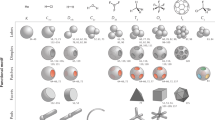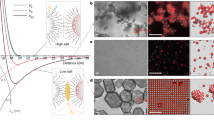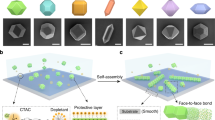Abstract
Micrometre- and nanometre-sized particles play important roles in many applications, including catalysis1, optics2,3, biosensing4,5,6,7,8 and data storage9. Organic particles10 are usually prepared through polymerization of suitable monomers11 or precipitation methods12. In the case of inorganic materials, particle fabrication tends to involve the reduction of a metal salt13, or the controlled mixing of salt solutions supplying a metal cation and an elemental anion (for example, S2-, Se2-, O2-)14, respectively; in some instances, these methods even afford direct control over the shape of the particles produced14,15,16,17. Another class of materials are metal-organic coordination polymers18,19,20,21,22,23, which are based on metal ions coordinated by polydentate organic ligands and explored for potential use in catalysis18, gas storage19,20, nonlinear optics21 and molecular recognition and separations22,23. In a subset of these materials, the use of organometallic complexes as ligands (so-called metalloligands) provides an additional level of tailorability, but these materials have so far not yet been fashioned into nano- or microparticles. Here we show that simple addition of an initiation solvent to a precursor solution of metal ions and metalloligands results in the spontaneous and fully reversible formation of a new class of metal–metalloligand particles. We observe initial formation of particles with diameters of a few hundred nanometres, which then coalesce and anneal into uniform and smooth microparticles. The ease with which these particles can be fabricated, and the ability to tailor their chemical and physical properties through the choice of metal and organic ligand used, should facilitate investigations of their scope for practical applications.
This is a preview of subscription content, access via your institution
Access options
Subscribe to this journal
Receive 51 print issues and online access
$199.00 per year
only $3.90 per issue
Buy this article
- Purchase on Springer Link
- Instant access to full article PDF
Prices may be subject to local taxes which are calculated during checkout




Similar content being viewed by others
References
Bell, A. T. The impact of nanoscience on heterogeneous catalysis. Science 299, 1688–1691 (2003)
Wang, J., Gudiksen, M. S., Duan, X., Cui, Y. & Lieber, C. M. Highly polarized photoluminescence and photodetection from single indium phosphide nanowires. Science 293, 1455–1457 (2001)
Blanco, A. et al. Large-scale synthesis of a silicon photonic crystal with a complete three-dimensional bandgap near 1.5 micrometres. Nature 405, 437–440 (2000)
Cao, Y. C., Jin, R. & Mirkin, C. A. Nanoparticles with Raman spectroscopic fingerprints for DNA and RNA detection. Science 297, 1536–1540 (2002)
Bruchez, M. Jr, Moronne, M., Gin, P., Weiss, S. & Alivisatos, A. P. Semiconductor nanocrystals as fluorescent biological labels. Science 281, 2013–2016 (1998)
Taton, T. A., Mirkin, C. A. & Letsinger, R. L. Scanometric DNA array detection with nanoparticle probes. Science 289, 1757–1760 (2000)
Mirkin, C. A., Letsinger, R. L., Mucic, R. C. & Storhoff, J. J. A DNA-based method for rationally assembling nanoparticles into macroscopic materials. Nature 382, 607–609 (1996)
Elghanian, R., Storhoff, J. J., Mucic, R. C., Letsinger, R. L. & Mirkin, C. A. Selective colorimetric detection of polynucleotides based on the distance-dependent optical properties of gold nanoparticles. Science 277, 1078–1081 (1997)
Sun, S., Murray, C. B., Weller, D., Folks, L. & Moser, A. Monodisperse FePt nanoparticles and ferromagnetic FePt nanocrystal superlattices. Science 287, 1989–1992 (2000)
Horn, D. & Rieger, J. Organic nanoparticles in the aqueous phase—theory, experiment, and use. Angew. Chem. Int. Edn Engl. 40, 4331–4361 (2001)
Roscoe, S. B., Fréchet, J. M. J., Walzer, J. F. & Dias, A. J. Polyolefin spheres from metallocenes supported on noninteracting polystyrene. Science 280, 270–273 (1998)
Fu, H.-B. & Yao, J.-N. Size effects on the optical properties of organic nanoparticles. J. Am. Chem. Soc. 123, 1434–1439 (2001)
Henglein, A. Reduction of Ag(CN)2- on silver and platinum colloidal nanoparticles. Langmuir 17, 2329–2333 (2001)
Peng, X. et al. Shape control of CdSe nanocrystals. Nature 404, 59–61 (2000)
Chen, J., Herricks, T. & Xia, Y. Polyol synthesis of platinum nanostructures: control of morphology through the manipulation of reduction kinetics. Angew. Chem. Int. Edn Engl. 44, 2589–2592 (2005)
Jin, R. et al. Photoinduced conversion of silver nanospheres to nanoprisms. Science 294, 1901–1903 (2001)
Jin, R. et al. Controlling anisotropic nanoparticle growth through plasmon excitation. Nature 425, 487–490 (2003)
Seo, J. S. et al. A homochiral metal-organic porous material for enantioselective separation and catalysis. Nature 404, 982–986 (2000)
Rosi, N. L. et al. Hydrogen storage in microporous metal-organic frameworks. Science 300, 1127–1129 (2003)
Yaghi, O. M. et al. Reticular synthesis and the design of new materials. Nature 423, 705–714 (2003)
Evans, O. R. & Lin, W. Crystal engineering of NLO materials based on metal-organic coordination networks. Acc. Chem. Res. 35, 511–522 (2002)
Kosal, M. E., Chou, J.-H., Wilson, S. R. & Suslick, K. S. A functional zeolite analogue assembled from metalloporphyrins. Nature Mater. 1, 118–121 (2002)
Tabellion, F. M., Seidel, S. R., Arif, A. M. & Stang, P. J. Template and guest effects on the self-assembly of a neutral and homochiral helix. Angew. Chem. Int. Edn Engl. 40, 1529–1532 (2001)
Splan, K. E. et al. Photophysical and energy-transfer properties of (salen)zinc complexes and supramolecular assemblies. Eur. J. Inorg. Chem., 2348–2351 (2003)
Kilså, K. et al. Anchoring group and auxiliary ligand effects on the binding of ruthenium complexes to nanocrystalline TiO2 photoelectrodes. J. Phys. Chem. B 108, 15640–15651 (2004)
Ruck, R. T. & Jacobsen, E. N. Asymmetric catalysis of hetero-ene reactions with tridentate Schiff base chromium(III) complexes. J. Am. Chem. Soc. 124, 2882–2883 (2002)
Acknowledgements
C.A.M. acknowledges the US Air Force Office of Scientific Research, NIH, NSF and DARPA for supporting this research. We thank C. L. Stern for X-ray crystallographic analysis.
Author information
Authors and Affiliations
Corresponding author
Ethics declarations
Competing interests
Reprints and permissions information is available at npg.nature.com/reprintsandpermissions. The authors declare no competing financial interests.
Supplementary information
Supplementary Notes
This file contains Supplementary Methods, Supplementary Equation, Supplementary Discussion, Supplementary Figures 1–11 and Supplementary Tables 1 and 2. (PDF 2563 kb)
Rights and permissions
About this article
Cite this article
Oh, M., Mirkin, C. Chemically tailorable colloidal particles from infinite coordination polymers. Nature 438, 651–654 (2005). https://doi.org/10.1038/nature04191
Received:
Accepted:
Issue Date:
DOI: https://doi.org/10.1038/nature04191
This article is cited by
-
Direct synthesis of amorphous coordination polymers and metal–organic frameworks
Nature Reviews Chemistry (2023)
-
Metal-polyphenol Complexes as Versatile Building Blocks for Functional Biomaterials
Biotechnology and Bioprocess Engineering (2021)
-
Novel Self-assembly Coordination Lipid Polymers that Fold into Toroids with DNA-Delivery Potential
Journal of Inorganic and Organometallic Polymers and Materials (2021)
-
Versatile iron-vitamin K3 derivative-based nanoscale coordination polymer augments tumor ferroptotic therapy
Nano Research (2021)
-
Synthesis and characterization of amino and cyano-functionalized zinc-terephthalate metal–organic frameworks for loading of piroxicam drug
Chemical Papers (2020)
Comments
By submitting a comment you agree to abide by our Terms and Community Guidelines. If you find something abusive or that does not comply with our terms or guidelines please flag it as inappropriate.



